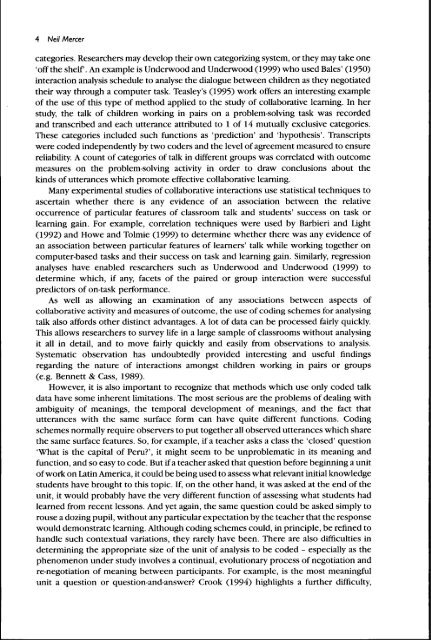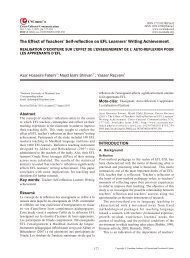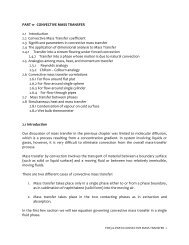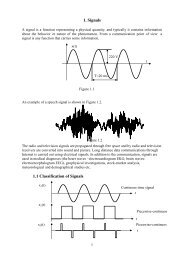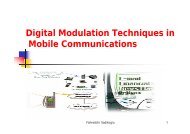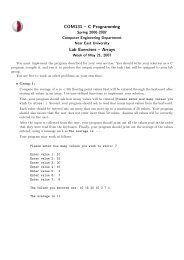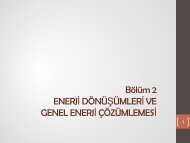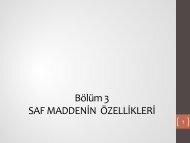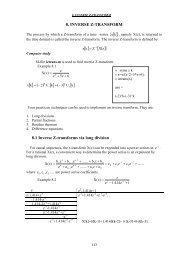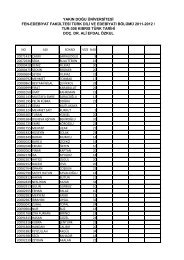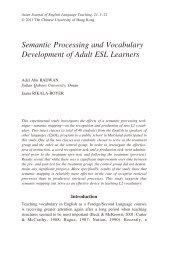(2010). The analysis of classroom talk: Methods and methodologies ...
(2010). The analysis of classroom talk: Methods and methodologies ...
(2010). The analysis of classroom talk: Methods and methodologies ...
You also want an ePaper? Increase the reach of your titles
YUMPU automatically turns print PDFs into web optimized ePapers that Google loves.
4 Neil Mercercategories. Researchers may develop their own categorizing system, or they may take one'<strong>of</strong>f the shelf. An example is Underwood <strong>and</strong> Underwood (1999) who used Bales' (1950)interaction <strong>analysis</strong> schedule to analyse the dialogue between children as they negotiatedtheir way through a computer task. Teasley's (1995) work <strong>of</strong>fers an interesting example<strong>of</strong> the use <strong>of</strong> this type <strong>of</strong> method applied to the study <strong>of</strong> collaborative learning. In herstudy, the <strong>talk</strong> <strong>of</strong> children working in pairs on a problem-solving task was recorded<strong>and</strong> transcribed <strong>and</strong> each utterance attributed to 1 <strong>of</strong> 14 mutually exclusive categories.<strong>The</strong>se categories included such functions as 'prediction' <strong>and</strong> 'hypothesis'. Transcriptswere coded independently by two coders <strong>and</strong> the level <strong>of</strong> agreement measured to ensurereliability. A count <strong>of</strong> categories <strong>of</strong> <strong>talk</strong> in different groups was correlated w^ith outcomemeasures on the problem-solving activity in order to draw conclusions about thekinds <strong>of</strong> utterances which promote effective collaborative learning.Many experimental studies <strong>of</strong> collaborative interactions use statistical techniques toascertain whether there is any evidence <strong>of</strong> an association between the relativeoccurrence <strong>of</strong> particular features <strong>of</strong> <strong>classroom</strong> <strong>talk</strong> <strong>and</strong> students' success on task orlearning gain. For example, correlation techniques were used by Barbieri <strong>and</strong> Light(1992) <strong>and</strong> Howe <strong>and</strong> Tolmie (1999) to determine whether there was any evidence <strong>of</strong>an association between particular features <strong>of</strong> learners' <strong>talk</strong> while working together oncomputer-based tasks <strong>and</strong> their success on task <strong>and</strong> learning gain. Similarly, regressionanalyses have enabled researchers such as Underwood <strong>and</strong> Underwood (1999) todetermine which, if any, facets <strong>of</strong> the paired or group interaction were successfulpredictors <strong>of</strong> on-task performance.As well as allowing an examination <strong>of</strong> any associations between aspects <strong>of</strong>collaborative activity <strong>and</strong> measures <strong>of</strong> outcome, the use <strong>of</strong> coding schemes for analysing<strong>talk</strong> also affords other distinct advantages. A lot <strong>of</strong> data can be processed fairly quickly.This allows researchers to survey life in a large sample <strong>of</strong> <strong>classroom</strong>s without analysingit all in detail, <strong>and</strong> to move fairly quickly <strong>and</strong> easily from observations to <strong>analysis</strong>.Systematic observation has undoubtedly provided interesting <strong>and</strong> useful findingsregarding the nature <strong>of</strong> interactions amongst children working in pairs or groups(e.g. Bennett & Cass, 1989).However, it is also important to recognize that methods which use only coded <strong>talk</strong>data have some inherent limitations. <strong>The</strong> most serious are the problems <strong>of</strong> dealing withambiguity <strong>of</strong> meanings, the temporal development <strong>of</strong> meanings, <strong>and</strong> the fact thatutterances with the same surface form can have quite different functions. Codingschemes normally require observers to put together all observed utterances which sharethe same surface features. So, for example, if a teacher asks a class the 'closed' question'What is the capital <strong>of</strong> Peru?', it might seem to be unproblematic in its meaning <strong>and</strong>function, <strong>and</strong> so easy to code. But if a teacher asked that question before beginning a unit<strong>of</strong> work on Latin America, it could be being used to assess what relevant initial knowledgestudents have brought to this topic. If, on the other h<strong>and</strong>, it was asked at the end <strong>of</strong> theunit, it would probably have the very different ftmction <strong>of</strong> assessing w^hat students hadlearned from recent lessons. And yet again, the same question could be asked simply torouse a dozing pupil, without any particular expectation by the teacher that the responsewould demonstrate learning. Although coding schemes could, in principle, be refined toh<strong>and</strong>le such contextual variations, they rarely have been. <strong>The</strong>re are also difficulties indetermining the appropriate size <strong>of</strong> the unit <strong>of</strong> <strong>analysis</strong> to be coded - especially as thephenomenon under study involves a continual, evolutionary process <strong>of</strong> negotiation <strong>and</strong>re-negotiation <strong>of</strong> meaning between participants. For example, is the most meaningftilunit a question or question-<strong>and</strong>-answ^er? Crook (1994) highlights a further difficulty.


